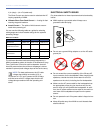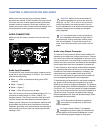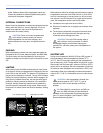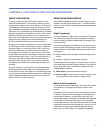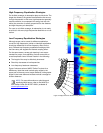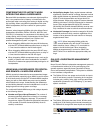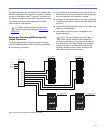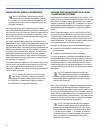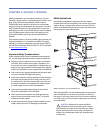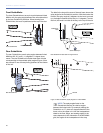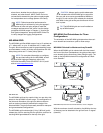
CHAPTER 4: LINE ARRAYS AND SYSTEM INTEGRATION
24
COMPENSATING FOR LATENCY WHEN
INTEGRATING MINA LOUDSPEAKERS
Because MINA loudspeakers use onboard digital amplifica-
tion, a very small amount of latency is introduced to the
audio signal when converting from analog to digital and dig-
ital to analog. When using MINA loudspeakers with other
MINA loudspeakers, this has no effect on system perfor-
mance.
However, when integrating MINAs with other Meyer Sound
loudspeakers (M’elodies, MICAs, 500-HPs, 600-HPs, and
700-HPs), it is necessary to compensate for this latency with
a delay setting, which is easily implemented with the Galileo
loudspeaker management system (see “Galileo Loud-
speaker Management System” on page 24).
■ When integrating MINAs within the same M’elodie array
with the MTF-M’elodie/MINA transition frame, a delay of
1.5 ms should be added to the M’elodie signal.
■ When integrating MINAs within the same 500-HP array
with the MTF-M’elodie/MINA transition frame, a delay of
1.8 ms should be added to the 500-HP signal.
■ When integrating MINAs as separate arrays, such as for
sidefill, in systems with other loudspeakers, use MAPP
Online Pro to determine appropriate delay settings for all
loudspeakers.
USING MINA LOUDSPEAKERS FOR SIDEFILL
AND DOWNFILL IN M’ELODIE ARRAYS
MINA’s acoustical characteristics ensure seamless integra-
tion with M’elodies, especially when MINA is used for down-
fill in M’elodie arrays (via the MTF-M’elodie/MINA transition
frame), as well as when MINA arrays are used as sidefills
with M’elodie main arrays. Understanding the differences
and similarities between the two loudspeakers is crucial to
designing and fine-tuning system coverage.
For combined M’elodie/MINA arrays, their design depends
on the following factors:
■ Number and Type of Array Elements: The number of
elements drastically affects the uniformity of coverage
for both SPL and frequency response. The number of
longer-throw, higher SPL elements (M’elodies) compared
to the number of downfill elements (MINAs) must be
carefully considered.
■ Vertical Splay Angles: Splay angles between cabinets
significantly impacts vertical coverage. Narrower vertical
splay angles between top elements (M’elodies) produce
higher Q vertical beamwidths and longer throws for
those elements. Wider splay angles for bottom elements
(MINAs) yield lower Q for high frequencies for those ele-
ments. Splay angles between higher SPL elements
(M’elodies) and downfill elements (MINAs) must be care-
fully considered in order to achieve smooth transitions.
■ Horizontal Coverage: Horizontal coverage for M’elodie
and MINA sections is fairly constant, regardless of the
number of array elements for each section or the splay
angles between them.
NOTE: When integrating MINAs within the
same M’elodie array with the MTF-M’elodie/
MINA transition frame, a delay of 1.5 ms should be
added to the M’elodie signal. When integrating
MINAs as separate arrays, such as for sidefill, use
MAPP Online Pro to determine appropriate delay set-
tings.
GALILEO LOUDSPEAKER MANAGEMENT
SYSTEM
Meyer Sound’s Galileo
®
loudspeaker management system is
a comprehensive solution for driving and aligning loud-
speaker systems, especially those comprised of Meyer
Sound self-powered loudspeakers. The system is available
in two hardware configurations:
■ The Galileo 616 is a two-space rack unit with six inputs
and 16 low-latency outputs. Processing for the outputs
includes gain, polarity, delay, high- and low-pass filters,
equalization (parametric and TruShaping™), and atmo-
spheric correction.
■ The Galileo 408 shares the same 24-bit, 96 kHz audio
quality and 32-bit floating point internal processing as
the Galileo 616, though with fewer inputs and outputs.
Galileo 616
Galileo 408
,1387 287387
6(/(&7
6,*1$/&/,3
087(
6(/(&7
6,*1$/&/,3
087(
INPUT OUTPUT
12345678
SIGNAL / CLIP
MUTE



